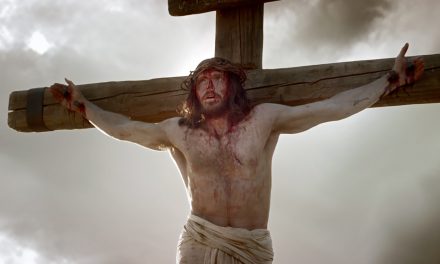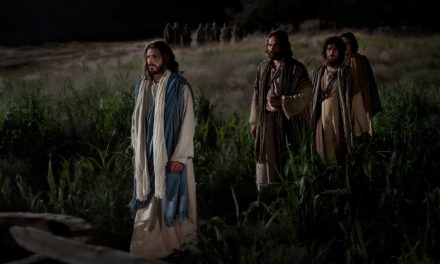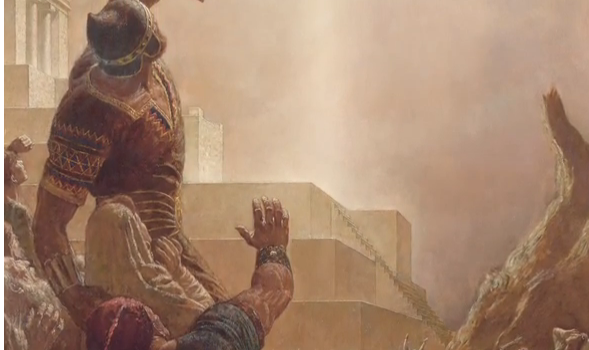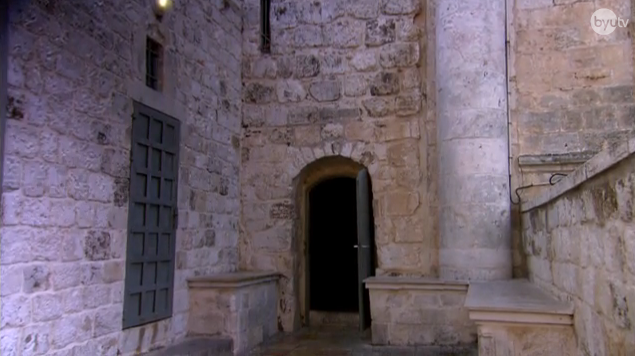Who is this ancient figure who stands at the crossroads of history? Is He a great teacher? A revolutionary? Prophet? Or is He indeed, the divine Son of a divine Father? The literal Savior of the world? In struggling to answer this question, many scholars dismiss the divine, and separate the Jesus of history, the mortal man, from the Jesus of faith, the Son of God. Today, Latter-day Saint scholars seek to join history and faith, scholarship and modern revelation, to reach a more complete understanding of who Jesus was, and is.
Following Jesus’ baptism in the River Jordan, the gospel writers describe the divine power and authority He manifests at the beginning of His ministry. His rebuke of the tempter in the wilderness, His cleansing of the temple in Jerusalem, and His calling of the twelve apostles to join His ministry are all evidence that Jesus acknowledges and accepts His calling as the long-promised Messiah.
JOHN S. TANNER: As a young boy, Jesus says to his parents, “Wist ye not that I must be about my Father’s business?” Luke records that “they understood not the saying which he spake unto them” (Luke 2:49–50). It appears that Jesus’ parents did not fully grasp His reference to His mortal ministry.
The more important and deeper question is, how aware was Jesus Himself of His messianic mission and His divine nature? Scholars have long debated this question of whether Jesus proclaims Himself to be the Messiah, or has divinity ascribed to Him by His later followers. Now this question strikes at the very root of Christianity.
THOMAS A. WAYMENT: Today, one of the heated debate among scholars is the issue of whether Jesus believed Himself to be the Messiah or the Savior of the world, or whether others placed those words in His mouth later after His death. And to understand the problem, and to understand why there’s even a debate—because when we read the New Testament it’s very obvious that he taught those things. We see John proclaim it, we see Jesus proclaim it. And behind that debate is a document, a hypothetical document, called Q. And what Q is, is scholars have noticed that there was some verbatim copying among the first three evangelists, Matthew, Mark, and Luke. And what they’ve done is they’ve taken those three gospels and tried to discern who was first, who was second, who was third. And by doing that we can determine who borrowed from whom. What we’re able to see is that Mark is almost certainly the earliest source. And once we take all of Mark out and we have Matthew and Luke standing side by side, we see roughly 65 sayings that are verbatim between those two gospel authors. But in those 65 sayings, it looks like those two authors used a source. That source is designated by scholars Q, after the German word for source or Quelle, as it’s said in German. That document then is believed to be the oldest Christian document.
Now once you have that document, and you’ve made those presuppositions, anything not in Q is secondary—secondary to Jesus, secondary to Christianity. And so you can make judgments, value judgments. Jesus in Q does not say He’s the Messiah, therefore Jesus didn’t say He was the Messiah, and other such things. But it’s a lot of leaps. And when you finally take all the leaps together, you can make some pretty dramatic conclusions—for example, Jesus didn’t believe He was the Messiah.
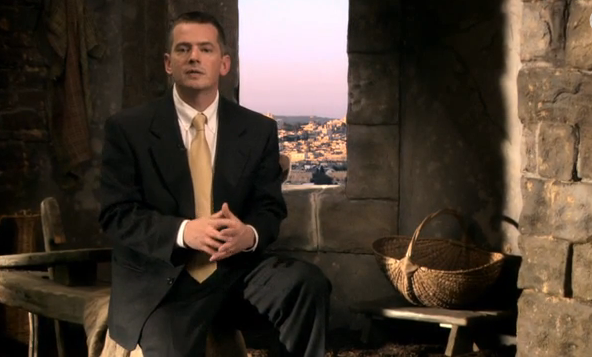 GAYE STRATHEARN: And there really develops this kind of this shift between a hermeneutic of faith and a hermeneutic of suspicion. By hermeneutic, I mean an interpretation. And this hermeneutic of suspicion was that there should be a, a distancing of the church from the academy. Thomas Aquinas used to say that we need reason to understand the scriptures, but he understood reason as being: understanding the mind and will of God. By the time we get into the Enlightenment, no — human reason is human reason; we don’t need anything else to help us to do that. So anything that we can’t explain by human reason are things that we should push to the side; we can’t discuss them. David Strauss would say, Miracles don’t happen—you can’t prove them by human reason.
GAYE STRATHEARN: And there really develops this kind of this shift between a hermeneutic of faith and a hermeneutic of suspicion. By hermeneutic, I mean an interpretation. And this hermeneutic of suspicion was that there should be a, a distancing of the church from the academy. Thomas Aquinas used to say that we need reason to understand the scriptures, but he understood reason as being: understanding the mind and will of God. By the time we get into the Enlightenment, no — human reason is human reason; we don’t need anything else to help us to do that. So anything that we can’t explain by human reason are things that we should push to the side; we can’t discuss them. David Strauss would say, Miracles don’t happen—you can’t prove them by human reason.
So the assumptions that you bring to the text are going to prejudice the results that you get out of the text. And certainly all of us have assumptions. There’s nobody that comes and reads a text that doesn’t bring assumptions with them. Biblical scholarship, their assumption is that God doesn’t exist, that he doesn’t—he isn’t a part of the worldly experience, and so therefore in the New Testament, when we see a combination of heaven and earth, that they must be ahistorical. And so they read the text very, very differently.
THOMAS A. WAYMENT: One of the other things that’s very hard for believers to understand, and scholars I think to understand likewise, is they are studying a people who believed, yet the scholars themselves don’t believe. And so we have this antagonism. How can a nonbeliever understand a believer, and in many ways, how can a believer understand a nonbeliever.
But the bottom line is that the presuppositions are going to determine what you find. If you believe in miracles, you don’t see that as a secondary thing. If you believe that Jesus was the Messiah, then when He says it, it can be original, it can go back to Jesus. But if you believe that Jesus wasn’t the Messiah, and He was a human, and that the miracles are legend, then when you look at that, you’re going to have to find a way to get that out of the story and get to the real Jesus, the scholarly Jesus.
JEFFREY R. CHADWICK: When John the Baptist reached about the age of thirty, he began his ministry as a prophet of God. The public reaction to him was immediately exciting and full of anticipation. The Jewish public had not seen a prophet of God in generations, but they readily recognized him as such in his role.
CAMILLE FRONK OLSON: People hear John, and they come out of the cities to see him. We read of multitudes very early on. Even some publicans and some of the soldiers are out there saying, What do we need to do? The outcry is really quite dramatic, and even to the extent in verse 15 of Luke 3, that “as the people were in expectation”—there’s this idea that there’s an anticipation for something. And the rest of this verse gives an indication of what that is: “All men mused in their hearts of John, whether he were the Christ or not” (Luke 3:15). Is this the long-awaited Messiah? That expectation, that anticipation is there. In many ways, in their minds John fit the bill, and they are coming out in masses from the cities to hear him, wanting to make changes.
JEFFREY R. CHADWICK: In John chapter 1 we read, particularly in verse 24, that many who came were sent of the Pharisees, and they were among those asking him, Who art thou, and what is your mission here? The Pharisees, like the Jewish populace, honored John as a prophet, and were both disappointed and deeply saddened at his execution at the hands of King Herod Antipas.
However, the Sadducees, those chief priests and elders who ran the government and the administration of Judea and Jerusalem, were decidedly unhappy with John the prophet, for a number of reasons. First and foremost, their belief was that the prophetic era had ended, and the Sadducees resisted any new attempts to bring about prophetic exercises. Secondly, the Sadducees vehemently opposed the notion of a Messiah of Israel, one who would come to be king and who would change the order of things, including the political order. The Sadducees—chief priests and elders—were allies of Rome, and in fact they were collaborating with Rome in the government of Judea. While the Roman governor ran the affairs of Judea in a macro sense, the Sadducees, led by the high priest, governed Jerusalem in the local sense, and they did not need a new prophet bringing forth prophecies of the coming Messiah to disturb the smooth operation of their doings in Jerusalem and at the temple mount. So Pharisee leaders, including people like Nicodemus, who sat on the Jewish senate, the Sanhedrin of 71 members, were probably very excited by John’s appearance. The Sadducees opposed John as strongly as they would eventually oppose Jesus.
GAYE STRATHEARN: After Jesus goes to the temple when he’s 12 years of age, the only scriptural record that we have of Jesus’ life comes from Luke, who tells us that he returns to Nazareth and remains subject to his parents. We know nothing about the adolescent Jesus nor about the man in his 20s. In fact it’s not until the 15th year of the reign of Tiberius Caesar, when Jesus is about 30 years of age, that he bursts on to the scene, as narrated by each of the four gospel writers. And each of the accounts follow Jesus here, to the Jordan River, seeking out John the Baptist.
CAMILLE FRONK OLSON: The first actual meeting between John and Jesus that is recorded in scripture is at the baptism of Jesus, as Jesus comes to Jordan, Bethabara, the place of the crossing, to find John to be baptized.
GAYE STRATHEARN: John is sitting there and he’s going, I shouldn’t be baptizing you, I’m not worthy to be baptized of you. But Jesus says, Suffer it to be so anyway, for thus it is needed to fulfill all righteousness (see Matthew 3:15). He’s acknowledging that he doesn’t fit in terms of John is baptizing for repentance. Nevertheless, He will be baptized.
And I think a really nice place where the Book of Mormon dovetails in here is that the Bible really doesn’t tell us what it means to fulfill all righteousness, but if we go to 2nd Nephi, chapter 31, where Nephi, having seen in vision this very experience, is reflecting back on that day. He notes very much, what does it mean to fulfill all righteousness? Well, it is to show the children of men that Jesus would be humble, and to show His Father that he would be obedient. And so Christ is willing to submit to be baptized, recognizing—John the Baptist recognizing Him that He doesn’t need it, but He’s going to do it, to show an example to us and to His Father.
JEFFREY R. CHADWICK: Though He needed no forgiveness of sin, still that authorized preparation, the carrying out of the ordinance, which also would prepare Him to fulfill His mission as an adult, was necessary to receive from John. And so John did Jesus’ bidding and immersed Him in the waters of Jordan.
CAMILLE FRONK OLSON: When Jesus was baptized and came straightway out of the water, the heavens were opened, and he saw the spirit of God descending on him like a dove and lighting upon him. “Lo, a voice from heaven saying, This is my beloved Son, in whom I am well pleased” (Matthew 3:16–17).
There’s something different that happens this time that seems to be the confirming witness. This time, a sign of a dove, and witness from the Holy Ghost, gives that deeper witness to John, that not only is this a remarkable man who has come to be baptized, this truly is the Son of God. No question, John knows exactly who this is. He knows it through the witness of the spirit. This is the Son of God. He is fulfilling part of his role as a forerunner, as an Elias. He and only he, foreordained to baptize the Son of God. He knows he has done it.
ANDREW SKINNER: Not very far from here, Jesus was baptized. Just over my right shoulder is the ancient city of Jericho, and just beyond that, the River Jordan, where we believe that Jesus was baptized. Jesus’ baptism was an extraordinary example of obedience to His Father’s commands and His Father’s desires. And I think it’s fair to say that for most people that Jesus’ baptism marks the beginning of His mortal ministry. And I think one would naturally expect that after such a demonstration of His power and authority given at his baptism, that Jesus would immediately go to Jerusalem and begin preaching and teaching and exhorting up on the crest of the hill and also beyond that in the temple where He taught often. But in fact such was not the case. Many people hold that Jesus comes here near the ancient city of Jericho. This desert, barren wilderness becomes a place of fasting and prayer for the Savior. And at the end of 40 days, it also becomes a place of temptation.
S. KENT BROWN: To understand the Judean wilderness, one needs a sense of the topography of this region. We start first of all with Jerusalem, here. On the west side of the Mount of Olives, there is a road that runs around the south end of the Mount of Olives and down to the Dead Sea, called The Way of Salt. There’s another road that comes up over the top of the Mount of Olives, coming through the Kidron Valley, down the east slope as far as Jericho. Between these two roads, as well as to the north and to the south, lies the wilderness of Judea. There’s nothing flat about this topography. It’s all hills that have been worn over the millennia, by rain, wind, and so on.
ROGER R. KELLER: Jesus does fast in the wilderness for a period of 40 days. He seems to have been sustained by the spirit over that period of time. And as that period ends, it’s at that point that Satan comes to Him. And it is there that he then begins to challenge Him, and to tempt Him. Actually, probably the word temptation can also be translated as “trial.” And so these were truly trials that the Savior was put through. There’s no question that there were temptations, but definitely this was His trial prior to the ministry that never left Him then for the rest of His life, as He sought to fulfill what His Heavenly Father called him to be and to do.

